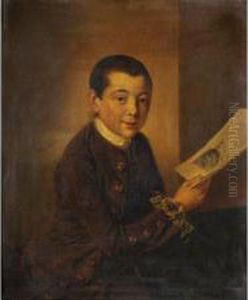John Van Rymsdyk Paintings
Jan van Rymsdyk, also known as John van Rymsdyk, was a Dutch artist who gained prominence for his detailed anatomical and natural history illustrations in 18th century England. While his exact birth and death dates are not precisely known, it is believed that he was born around 1750 and died around 1788. He is particularly known for his work with obstetrician William Hunter, contributing significantly to Hunter's anatomical atlas, 'The Anatomy of the Human Gravid Uterus Exhibited in Figures', published in 1774.
Van Rymsdyk's illustrations were highly valued for their accuracy and aesthetic quality. He was skilled in depicting the intricate details of human anatomy, which made his work an invaluable resource for medical professionals and students. His ability to capture the complexity of the internal human form in such a lifelike manner helped advance the study of obstetrics and medical science in general.
Apart from his contributions to Hunter's works, van Rymsdyk also provided illustrations for other medical and scientific publications of the time. His legacy in the field of medical illustration is significant; his drawings are still considered some of the finest examples of the genre. Despite the importance of his work, many details of his life and career remain obscure, and much of what is known about him comes from the records of the individuals he collaborated with.
Little is known about van Rymsdyk's personal life or training. His works suggest that he had a profound understanding of both art and science, a combination that was essential for the production of high-quality medical illustrations. During his lifetime, he would have been part of a burgeoning community of artists in England who specialized in scientific illustrations, a field that was becoming increasingly important as a means of documenting discoveries and sharing knowledge in an era before the advent of photography.
After his death, van Rymsdyk's contributions continued to influence the fields of medical illustration and anatomy. His drawings remain a testament to the skill and precision that artists brought to the interpretation of scientific information during the Enlightenment. Although not as widely known as some of his contemporaries, van Rymsdyk's work has endured as an example of the critical role that art has played in the advancement of medical understanding.
